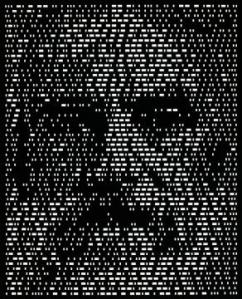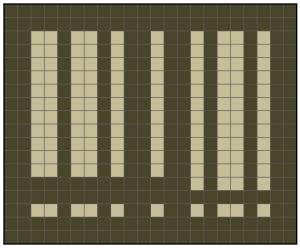[caption id="attachment_627" align="alignleft" width="243" caption="Samuel F. B. Morse - © Ken Knowlton, 1999"] [/caption]
[/caption]
The inaugural batch of cutting boards is in production. It includes standard 16" x 20" x 2" monogrammed counter top boards (both one-sided and two sided with an au jus groove), as well one designed to fit over a sink (with a hole and a container to toss your onion skins!) and a thicker 3"+ board to be installed in a recess in a work surface. ( Shoot me an email if you'd like your own.)
All feature the Morse code design, and will be made of walnut and maple.
So, seriously, what's with the Morse code?
I designed this for myself because I wanted to make my dinner on something worth making my dinner on. Something substantial and worth looking at. Something hand-made. And something personalized but not obviously so. I like to buy things that will last and buy them once.
I’m fascinated by the blending of art and science, and importance of innovation. Years ago in undergrad I originally majored in biology, but then also art history. Later business school. Now Gowanus Furniture Co. Go figure. I proudly don’t have a speciality.
People forget that Samuel Morse was a highly regarded artist who invented the code after he was away from home at the time of his wife’s death. He only learned of her passing well after the fact because there was no effective means of rapid communication at the time. He then decided to solve that problem.
Morse code is old and people don’t really know how it works anymore, but it’s still effective. The telegraph revolutionized how we interact and communicate with one another. Some have even referred to it as the Victorian Internet. These days txts and email are more effective, sort of, but not in every way. And Morse code still does work. And it always will. There’s no equipment. It’s an idea. Whistles, flashlights, smoke signals, or a telegraph will can all convey the information
I want to remember and celebrate game-changing ideas. Those old ideas are always supplanted by new disruptive technologies (i.e. progress), but let’s not forget those that did revolutionize our society. Especially ones that made information more accessible and allowed distances to shrink and brought people together.
This is about starting conversations.
Use this board when you make dinner. Do it yourself. And invite over your friends, too.
I made this board for you and your name is in it. Most others won’t notice that at first, but it’s a cool story.
Tell them.
Morse code is also the most elegant and efficient way I could think of to personalize the board. My original thought was to use the standard UPC bar code format (it’d be scannable!), but then for one letter the cutting board would have to be over two feet wide. Not going to work. Inefficient. I also briefly considered binary code, but that too needed too much space, and, while comprising only two states (i.e. 1 & 0) like the cutting board (walnut and maple), how to indicate the where one letter ends and the next begins? And I’m not getting into checksums and error correction. It works for computers, but not for people.
Here are my initials, PER, in binary:
010100000100010101010010
Yeah, no.
The cutting board had to be designed for people, and the layout and means of construction of the cutting board had to lend itself to this sort of communication.
This is PER in Morse code. I think it looks pretty hot.
It's a cutting board that fosters interaction.
We spend a lot of time eating. Make the experience as worthwhile as possible.]]>



Comments
[…] Just get a customized end-grain cutting board, when you can get one that your Morse-fluent friends will know is yours? Paul Raho’s Gawanus Fruniture Co. designs and hand-makes […]